Ijraset Journal For Research in Applied Science and Engineering Technology
- Home / Ijraset
- On This Page
- Abstract
- Introduction
- Conclusion
- References
- Copyright
Design and Analysis of Smoke and Fire in Enclosed Spaces using CFD
Authors: Talari Rajkumar, Dr. G. Satish
DOI Link: https://doi.org/10.22214/ijraset.2024.63431
Certificate: View Certificate
Abstract
The available figures demonstrate that automobile fires have caused a significant number of fatalities in recent years, amounting to millions of deaths. The deaths were caused by explosions that occurred inside motor vehicles. The majority of research has shown that asphyxiation caused by smoke is the leading cause of death, exceeding burn injuries in terms of mortality. The majority of the study led to this conclusion. As a result, modern society constructs a substantial number of parking lots with ventilation systems that allow unrestricted smoke movement in the event of a fire. Moreover, the use of the CFD software has been shown to be beneficial in developing an effective ventilation system for an underground parking garage, leading to a reduction in the need for experimental testing. This result has been achieved through the use of the CFD program. We widely acknowledge FLUENT and Pyrosim FDS as computational fluid dynamics (CFD) software for smoke analysis. We use both programs for smoke analysis. We use both instruments to evaluate smoke. The research utilizes computational fluid dynamics (CFD) techniques to design and evaluate a ventilation system for an underground parking facility. A comparative study was performed to ascertain the parallels and disparities between the two simulation programs, considering the mathematical models, simulation domains, and simulation theories related to them. The statistics unequivocally establish that Pyrosis FDS is a very effective software for modeling building fires. The mention of fluid was used to exemplify this notion. This is because it provides versatility in terms of constructing models, assigning boundary conditions, achieving accurate outputs, and significantly reducing processing time and resource requirements. This is the underlying reason for this problem. We used computational fluid dynamics (CFD) simulations in conjunction with the Taguchi experimental design to optimize the ventilation system of the car park garage. We undertook this action to achieve our intended objectives. The chosen criteria included the orientation angle of the jet fans, the number of jet fans, and the kind of exhaust, with each characteristic having two levels. After thorough consideration by all parties concerned, this conclusion was reached. According to the findings, the mix of components and their respective amounts showed the most potential for attaining both efficiency and optimality. We devised certain criteria as part of the inquiry to aid in the development of an effective ventilation system for an underground parking garage. Computational fluid dynamics (CFD) established the assessment criteria.
Introduction
I. INTRODUCTION
Extinguishing a fire in a business institution's parking lot is difficult because standard procedures do not include measures for dealing with such a scenario. In order to successfully navigate this challenging circumstance, it is imperative that we make progress in enhancing fire safety practices. Subterranean parking lots often use ventilation systems to reduce the quantities of carbon monoxide and other pollutants produced by vehicles. During a fire, ventilation serves the purpose of removing smoke and heat from the area. Before deploying the system, building managers, owners, and architects must verify that it satisfies the requisite standards for smoke extraction and fire laws. The implementation stage completes this before the system becomes functional. Ventilation systems in parking lots have two primary purposes: facilitating the dispersion of car emissions and extracting smoke in the event of a fire. Insufficient ventilation in underground parking lots might result in inadequate air quality. This is an important factor to consider. The most critical issue to address is the release of carbon monoxide (CO). When the concentration of carbon monoxide (CO) goes over a certain level, it quickly combines with human hemoglobin, causing a reduction in the blood's ability to transport oxygen. Once we exceed the threshold value, this will occur promptly. The carbon monoxide (CO) content in a parking garage may vary due to a variety of factors.
The subsequent variables are:
- It is important to consider the duration of travel and maintenance time in the garage, the number of functioning cars in the garage, and the emission rate of the vehicles as crucial factors.
- Consequently, it is crucial to ensure that the concentration of carbon monoxide in the underground parking lot remains below the threshold amount.Moncef Krarti (2001) suggests that the concentration of carbon monoxide in parking garages should not surpass 35 parts per million. This advice is derived from the existing norms and guidelines.
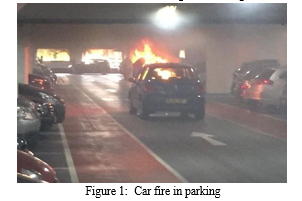
II. LITERATURE REVIEW
Noordijk and Lemaire [1]. This study focuses on how to model fire spread between cars in a car parking building in which was triggered by a fire incident at Schiphol Airport, Netherlands involving 30 cars where it was believed that the fire spread during the incident was much faster than assumed. The study recognised that fire between vehicles can occur by 20 emission of radiation, heat transfer through air and absorption of the radiation. The work then introduces a fire spread model using CFD. In the conclusion, driven by uncertainties, the fire spread model was capable of predicting fire spread between cars even though it was not clear from the paper what the measure of the capability was. Noordijk and Lemaire also reiterated that the model is still in a development phase and needs further validation and improvement. Jug et al. [2]. This study attempted to provide a baseline for performance-based design of car park buildings using probabilistic methods. However, the main objective was unclear and there was no clear method on how the authors attempted to address the problem. Olthof and Scheerder [3]. The objective of this study was to understand underground car parks fire scenarios that may occur at the time the fire brigade arrives at the scene. The outcome of this research could be used to develop a fire fighting strategy for underground car parks. The outcome of the research could also give authority bodies much needed information to adjust fire safety measurements in the designing process. For this research, the outcomes were “used by fire department of Apeldoorn for their fire fighting strategies”. The outcome of the research has been based on literature research, statistics, fire investigation and field tests. Two fire scenarios were determined and used from the analysis of research data in combination with a probabilistic and physical approach.
Deckers (2007) [4]. The research discussed the simulation of smoke and heat exhaust ventilation system (SHEVS) in large enclosed car parks. This was done by comparing with standard (NBN 208-20-2) of the Dutch standards. This type of solution was tested by simulating various scenarios using the FDS simulation software. Tilley (2007) [5]. This report was a summary of a study regarding a fire in a small underground car park. From the research, it was found that there was quite a trend in Belgium to have more small underground car parks. The definition of small was enough space for about ten cars. The thesis also discussed types of measures taken in Belgium to protect these underground car parks against fire. These measures were investigated using the FDS simulation software. Jansen (2010) [6]. The thesis discussed the selection of car fire scenarios in car park buildings, the modelling of the fire scenarios and the resulting thermal load on structures as well as the local heating and strength reduction of the structure. The scenarios were chosen based on past realistic scenarios that have happened in the past. These scenarios were then simulated using the FDS simulation software. Baert (2011) [7]. The research mainly discussed fire safety of smoke and heat extraction systems in underground car parks. Topics discussed in the thesis were back layering of smoke, influence of beam configurations on back layering and delay of detection systems. A survey of regulations, standards and experiments on heat release rates of cars also were reported in the thesis. One topic which is of interest for this thesis is the compilation of the design fire of passenger vehicle which have been regularly used in car parks. The simulation used in this thesis was performed using the FDS simulation software.
III. PROBLEM STATEMENT AND OBJECTIVES
A. Problem Statement
- An analysis of the distinguishing variables between FLUENT and FDS, two numerical simulation tools used for parking garages, as well as an exploration of their similarities and contrasts.
- Taguchi design is used to create and optimize a ventilation system.
B. Objectives
- The main purpose of this project is to conduct research and acquire information about the effectiveness of the IVS (Impulse ventilation system) in controlling smoke and fire.
- The aim of this study is to evaluate the accuracy of the numerical simulations conducted using FLUENT and FDS in predicting the spread of smoke in a parking garage.
- In order to simulate smoke and fire in the parking garage, it is necessary to choose the simulation software that is most appropriate for the job.
- The use of DOE with the specific aim of enhancing ventilation in parking garages via construction and enhancement.
- To ascertain the parameter with the greatest influence on the design of the ventilation system.
IV. COMPARATIVE RESEARCH ON FLUENT
Six parameters define flow fields in the discipline of software simulation. We define the characteristics as velocity components along the corresponding coordinate directions. We include the u, v, and w parameters for the temperature field T, the concentration of smoke pollutant C, and the pressure of the flow field P. Smoke from a fire consistently adheres to a predictable flow pattern. This is because the rule of conservation of mass, which consists of an energy equation, a momentum equation, and a continuity equation, mandates that they all follow the same pattern.
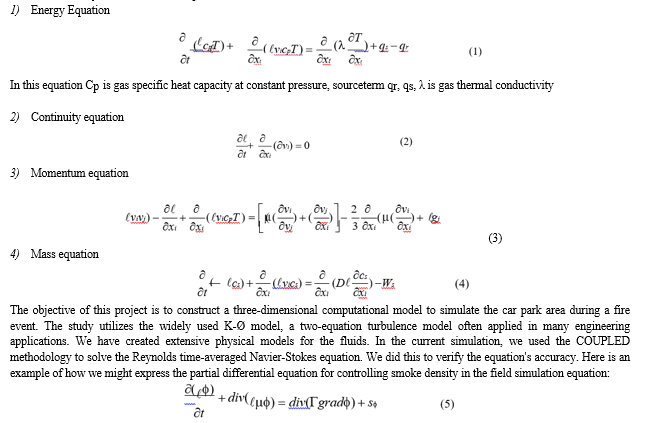
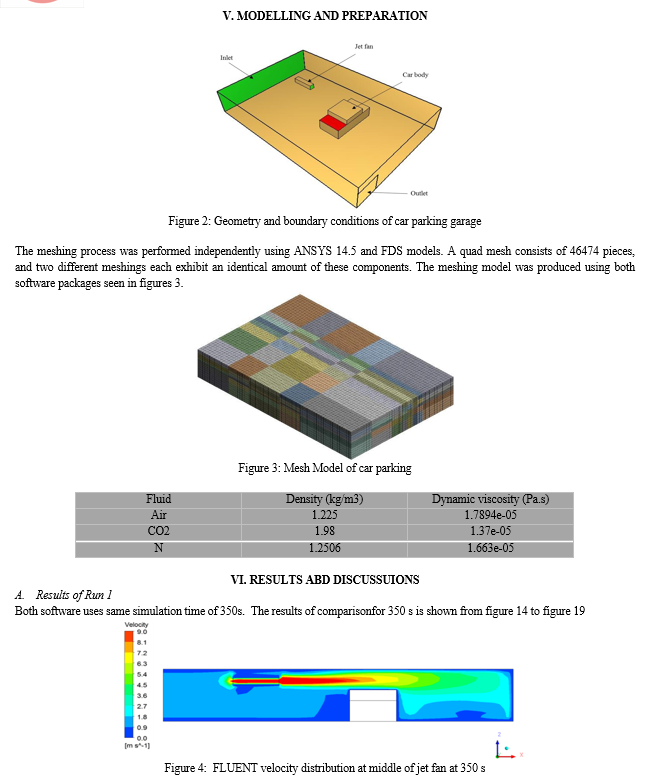
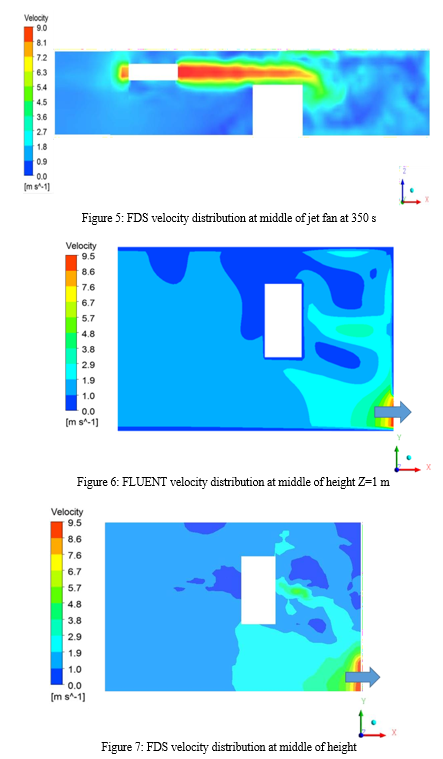
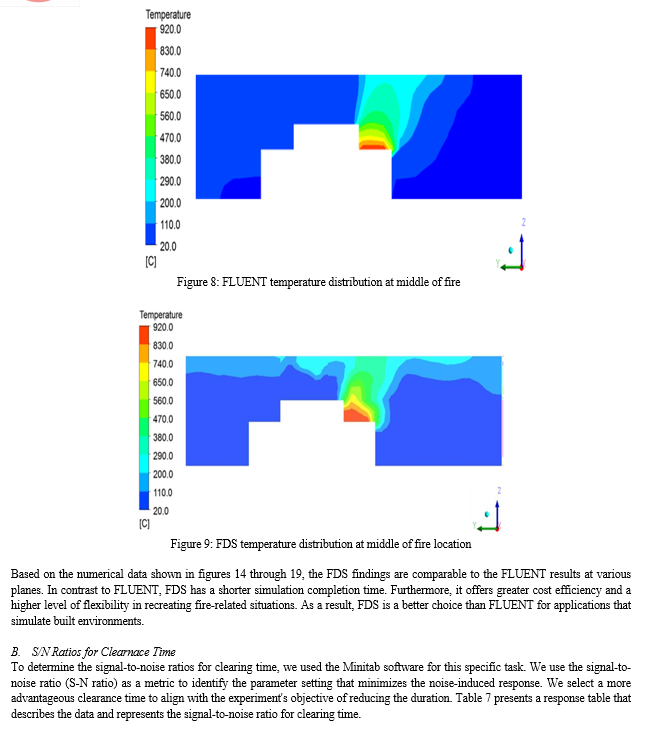
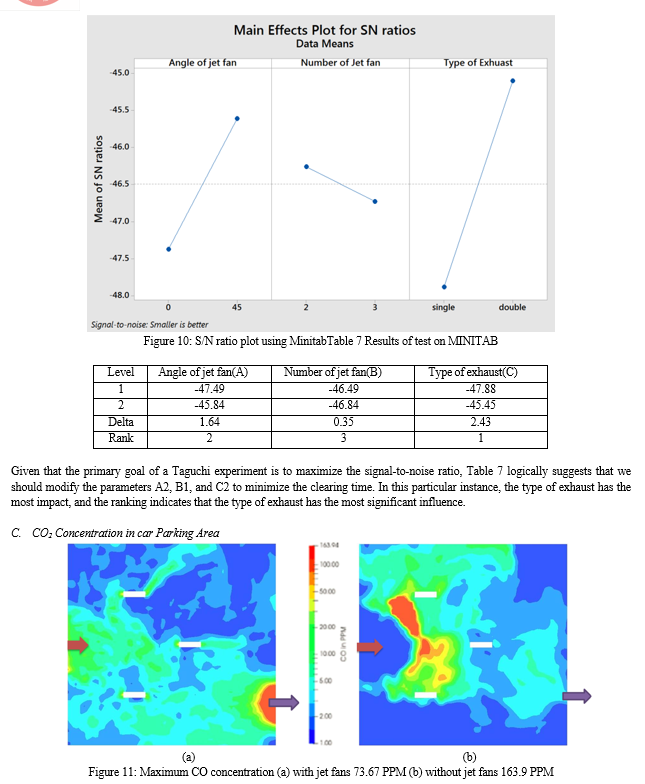
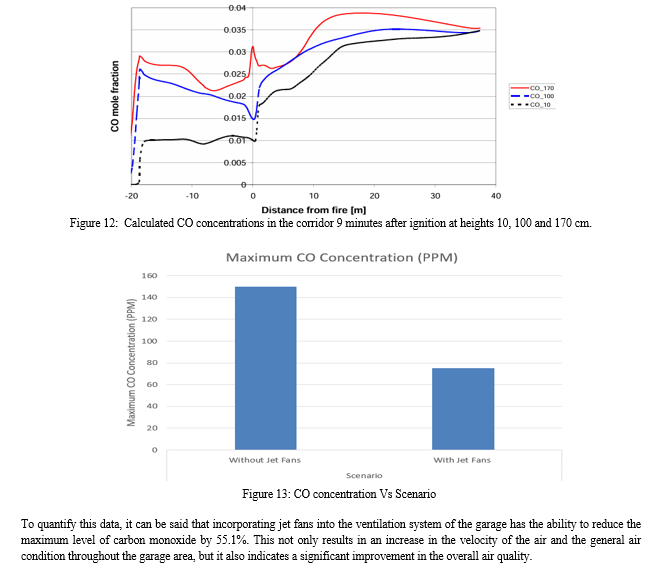
Conclusion
We used two simulation software programs, FLUENT and FDS, to analyze and compare studies on car fires occurring in parking garages. Comparing the simulation results from FLUENT and FDS leads to the following conclusion: 1) The Fire Defense System (FDS) is the optimal program for simulating building fires because of its extensive range of fire, jet fan, and vent modeling capabilities, its efficient simulation time, its unified interface, and its precision in identifying the optimal solution. This is due to the previously mentioned causes. 2) The results of simulating FDS and FLUENT are mostly comparable when a fire occurs in the center of a parking garage after 350 seconds. Based on our analysis, we can determine that FDS has the capability to simulate fire and smoke, and its level of accuracy is comparable to that of FLUENT. We achieve this outcome by considering all factors. 3) Moreover, the quality of the meshing determines the accuracy of the simulation results, according to simulation studies conducted on underground parking lots using the software packages FDS and FLUENT. Therefore, it is necessary to refine the meshing in order to obtain accurate results. To achieve greater precision. A. Stage 2 We used the Taguchi experimental design method to model and optimize the process of developing a parking lot. The FDS software enabled the successful completion of this work. This phase demonstrates how to use the Taguchi method to improve an electric motor\'s ventilation design. We have successfully completed this application. The research findings indicate that the Taguchi technique enables the discovery of optimum parameters with far less effort compared to the majority of other optimization approaches. The reason for this is that the Taguchi technique offers a very efficient and systematic procedure. When determining the required time for clearing, the type of exhaust fan is the most critical thing to consider, taking into account the many factors that impact it. The Taguchi approach has shown that the optimal combination for optimization is A2-B1-C2. We derived this conclusion from the procedure\'s results. These results suggest that it is advisable to position the jet fan at a 45-degree inclination, use two jet fans, and include a dual exhaust. Furthermore, it is advisable to orient the jet fan at a fifteen-degree inclination. B. Future Scope While the project accomplished its primary objective, there remains room for improvement in the ventilation design of the subterranean parking facility. One may arrive at this conclusion by examining both the outcomes and the summary of the whole discussion. Using Taguchi optimization on a large scale, taking into account the intricate geometry of the parking lot, is a suggested method to improve the outcomes. Incorporating more parameters into the optimization process may lead to the development of a parametric model.
References
[1] Noordijk, L. and Lemaire, T. (2005). Modelling of fire spread in car parks. HERON, vol. 50(4). [2] Jug, A., Petelin, S., and Bukovec, P. (2010). Designing an Underground Car Park Fire Scenarios on a Probabilistic Basis. Acta Chimica Slovenica, vol. 57, pp. 136 - 143. [3] Olthof, P. and Scheerder, R. (2011). „Brandscenario?s Geparkeerd?? Onderzoek naar brandscenario?s in ondergrondse parkeergarages. Deel 1: Rapport. Instituut voor Engineering, Brede Bachelor of Engineering, Uitstroomprofiel Fire Safety Engineering. [4] Deckers, X. (2007). Simulatie van rookafvoer bij brand in grote overdekte parkeergarages. Bachelor\'s degree dissertation, Universiteit Gent. [5] Tilley, N. (2007). Studie van brand in kleine ondergrondse parkeergarages. Bachelor\'s degree dissertation, Universiteit Gent. [6] Jansen, D. (2010). Autobranden in parkeergarages - brandscenario\'s, brandsimulaties en de gevolgen voor constructies. Postgraduate thesis, Universiteit Gent. [7] Baert, L. (2011). Evaluatie en ontwikkeling van methoden voor een brandveilig ontwerp van RWA installaties in ondergrondse parkeergarages. Master\'s thesis, Universiteit Gent. [8] A.D. Lemaire, J.L.M. Hensen (2013) Fire safety assessment of semi-open car parksbased on validated CFD simulations. [9] Ali celen (April 2015), CFD Analysis of Smoke and Temperature Control System of an Indoor Parking Lot with Jet Fan. Journal of Thermal Engineering, Yildiz Technical University Press, Istanbul, Turkey Manuscript Vol. 1, No. 2, pp. 116-130. [10] B. Merci(2013), Smoke and heat control for fires in large car parks: Lessonslearnt from research?, fire Safety Journal 57. [11] Cai Yun, Li Lidan (2007). The Analysis of the Circulates Mode of Ventilation System in the Case of Fire of Subway [J]. Journal of the Chinese People s Armed Police Force Academy, 23(2): 28-31. [12] (2007) CFD Modelling of Car Park Ventilation System, user guide for designers and regulators, Federation of Environmental Trade Associations. [13] Eleni A (2009), “CO dispersion in a car repair shop” Seventh International Conference on CFD in the Minerals and Process Industries CSIRO, Melbourne, Australia 9-11. [14] Lu S., Wang Y.H., Zhang R.F. and Zhang H.P. (2011) ‘’Numerical Study on Impulse Ventilation for Smoke Control in an Underground Car Park’’, Procedia Engineering, Vol. 11, pp. 369–378. [15] Qian Zhang (2013), A CFD simulation of hydrogen dispersion for the hydrogen leakage from a fuel cell vehicle in an underground parking garage, International journal of hydrogen energy 38 [16] R.Ramkumar (2015), Enhancement of Fire Evacuation System in Car Parking Area Using CFD, SSRG International Journal of Mechanical Engineering (SSRG-IJME) – volume 2 Issue 6. [17] Viegas J. (2010), The use of impulse ventilation for smoke control in underground car parks, Tunnelling and Underground Space Technology, Vol. 25, pp. 42–53. [18] Wang H (2008), The design and implement of automatic control system for large-scale coal spontaneous combustion experiment unit. Journal of Xi an University of Science and Technology, 28(1):6~10. (in Chinese)
Copyright
Copyright © 2024 Talari Rajkumar, Dr. G. Satish. This is an open access article distributed under the Creative Commons Attribution License, which permits unrestricted use, distribution, and reproduction in any medium, provided the original work is properly cited.

Download Paper
Paper Id : IJRASET63431
Publish Date : 2024-06-23
ISSN : 2321-9653
Publisher Name : IJRASET
DOI Link : Click Here
 Submit Paper Online
Submit Paper Online

